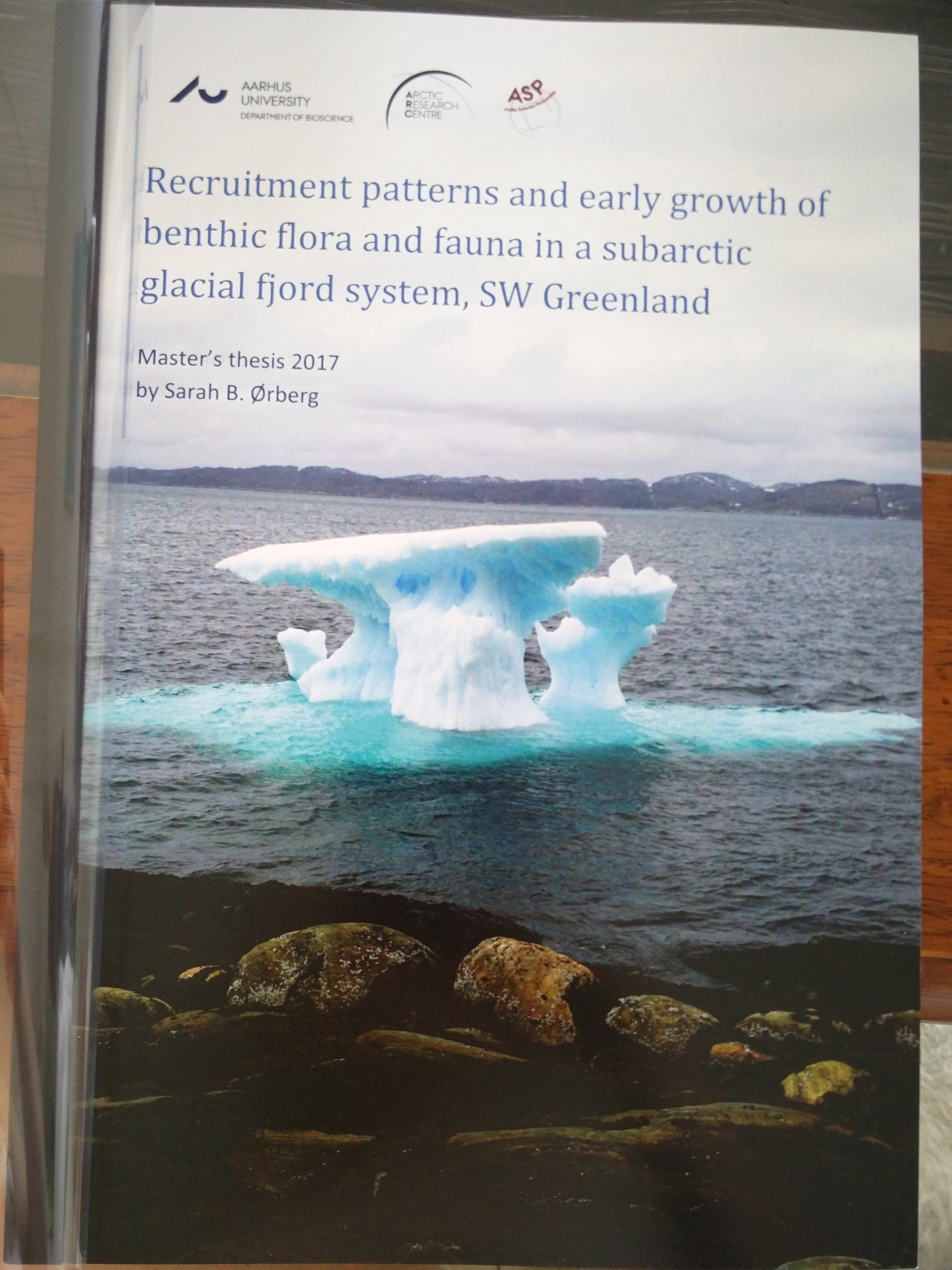Recruitment patterns and early growth of benthic flora and fauna in a subarctic glacial fjord system, SW Greenland
On 29 June 2017 Sarah B. Ørberg finished her Master's degree at Arctic Research Centre

Summary
Atmospheric warming has accelerated the mass loss of glacial ice in the Arctic, increasing the risk of changes in the physico-chemical environment within glacial fjord systems, which may affect the persistence, connectivity and distribution of marine organisms. Especially, marine benthos is susceptible to an increase in ice scour events and changes in surface temperatures, salinity and light conditions. These communities depend highly on recruitment (addition of juveniles to the population), as most of the species are immobile or slow moving as adults, limiting the ability to escape immediate changes in the surrounding environment. Hence, understanding what drives recruitment and early growth of Arctic benthos is important, as physical exposure is considered a key driver in the Arctic compared to milder environments.
In my thesis, I studied potential abiotic and biotic drivers of benthic recruitment and early growth in a subarctic glacial fjord system in SW Greenland, the Godthåbsfjord system. In the first experiment, settling plates were deployed in the subtidal at 3 spatial scales (fjord system, fjord, site) and 3 temporal scales (summer, winter, 1 year), to study how benthic recruitment varies in space and time and in relation to abiotic factors. Here, I found that variation in benthic recruitment and growth was likely influenced by the large-scale variation in physical parameters, such as temperature and salinity, created by glacial meltwater and ice. In addition, I observed that substrate modification by the macroalga Demarestia aculeata likely affects recruitment of barnacles negatively and mussels positively, indicating that timing in disturbance and settlement of different species is important in structuring these communities. Moreover, I found that kelp recruitment was highly variable in time and space, while showing a high growth potential once recruitment occurred. In a second experiment, intertidal canopy cover of the macroalga, Ascophyllum nodosum, was manipulated to test the hypothesis that canopy-forming algae facilitate faunal recruitment. Here, I found that canopy-forming macroalgae facilitate faunal recruitment to the understory, likely by dampening extreme air temperatures locally but not dampening ice scour. In addition, A. nodosum recruitment increased with higher substrate roughness and full recovery of the canopy was estimated to take ca. 15 years, presupposing a large supply of spores.
Overall, these results indicate that benthic recruitment and growth patterns in subarctic fjords are likely impacted by changes in glacial discharge of meltwater and ice. Moreover, biotic interactions, such as facilitation by modification of habitat structure and physical stressors, are important structural parameters of subarctic benthic communities and their recovery after physical disturbance. Finally, this study emphasizes that it is important to understand both abiotic and biotic drivers in Arctic benthic communities, to be able to target the relevant scale of biological communities when predicting impacts of climate change on benthic communities and future species distribution. Summary Atmospheric warming has accelerated the mass loss of glacial ice in the Arctic, increasing the risk of changes in the physico-chemical environment within glacial fjord systems, which may affect the persistence, connectivity and distribution of marine organisms. Especially, marine benthos is susceptible to an increase in ice scour events and changes in surface temperatures, salinity and light conditions. These communities depend highly on recruitment (addition of juveniles to the population), as most of the species are immobile or slow moving as adults, limiting the ability to escape immediate changes in the surrounding environment. Hence, understanding what drives recruitment and early growth of Arctic benthos is important, as physical exposure is considered a key driver in the Arctic compared to milder environments. In my thesis, I studied potential abiotic and biotic drivers of benthic recruitment and early growth in a subarctic glacial fjord system in SW Greenland, the Godthåbsfjord system. In the first experiment, settling plates were deployed in the subtidal at 3 spatial scales (fjord system, fjord, site) and 3 temporal scales (summer, winter, 1 year), to study how benthic recruitment varies in space and time and in relation to abiotic factors. Here, I found that variation in benthic recruitment and growth was likely influenced by the large-scale variation in physical parameters, such as temperature and salinity, created by glacial meltwater and ice. In addition, I observed that substrate modification by the macroalga Demarestia aculeata likely affects recruitment of barnacles negatively and mussels positively, indicating that timing in disturbance and settlement of different species is important in structuring these communities. Moreover, I found that kelp recruitment was highly variable in time and space, while showing a high growth potential once recruitment occurred. In a second experiment, intertidal canopy cover of the macroalga, Ascophyllum nodosum, was manipulated to test the hypothesis that canopy-forming algae facilitate faunal recruitment. Here, I found that canopy-forming macroalgae facilitate faunal recruitment to the understory, likely by dampening extreme air temperatures locally but not dampening ice scour. In addition, A. nodosum recruitment increased with higher substrate roughness and full recovery of the canopy was estimated to take ca. 15 years, presupposing a large supply of spores. Overall, these results indicate that benthic recruitment and growth patterns in subarctic fjords are likely impacted by changes in glacial discharge of meltwater and ice. Moreover, biotic interactions, such as facilitation by modification of habitat structure and physical stressors, are important structural parameters of subarctic benthic communities and their recovery after physical disturbance. Finally, this study emphasizes that it is important to understand both abiotic and biotic drivers in Arctic benthic communities, to be able to target the relevant scale of biological communities when predicting impacts of climate change on benthic communities and future species distribution.
